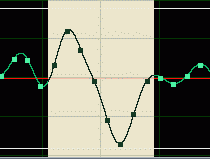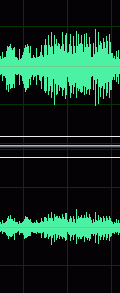|
Mind : in digital format it doesn't make a difference, if the duration is 2 milliseconds or a complete track of 5 minutes. The formula of a modification functions the same. Both a short sound-'sample' as a complete 'track' are the same kind of file. |
|
Rule 0 for samples : start and end with a zero-value..! The Zero-crossing : |

|
|
To prevent any unwanted ticks while using. Especially with 'looping'. Simple to do by a Fade-in of the beginning and a Fade-out of the end. ( A Fade-in starts with 0 % volume and ends the selection on 100 %. Fade-out vice versa, ) A few millisecs is enough and not really audible. Also with editing of a selection in the middle of a sample, like amplitude or filter, it is recommended to start and end the selection with a zero-crossing, again to avoid sharp jumps that can produce ticks. Remark : This is made after a strong zooming-in on a wav-sample. The square blocks represent the value of the 'sample-moment' of the system. So the highest resolution for editing. In this case, at 44100 Hz 16 bits stereo a time-difference of 0.000725 sec. between two blocks. The red line is here the zero-value. |
|
Rule 1 for samples :
Normalize
the volume. Normalization means : as loud as possible, without distortion. Still possible to lower the volume, while amplification can enhance bachground-noise. That's why the sound-recording for a sample needs to be as loud as possible. If a sample still needs to be edited (which they normally do) there is Rule 1a for samples : Only normalize at the end of the editing process. And do the modifications at a somewhat lower volume-level of the material, because often, after the modification, there is a big chance, that the total-volume has risen. Like equalizing where a frequency-range is amplified or like the mixing of several tracks where in fact the indivudual track-value are being added. |
Normalizing is a formula, where the file is scanned by searching for the point with the highest amplitude value and then the amplification is calculated to the maximum. If that maximum can be set ( % or dB ) it is better not to choose for that 100 % but 99, to be sure of non-clipping. No audible difference. The formula can deliver a problem. If this is the waveform : |

|
Then this sample can hardly be amplified because there is that peak of already 92 %. They can occur, due to a coincidence of added values or a clipping microphone. This can be corrected, by zooming in on the spot with that peak, selecting the area and lower the volume some dB. Again preferrable with a zerocrossing at begin and end : |

|
If there are more of those peaks in a file, they could be functional .. Ticks, strikes, hits, that are intentional in the sample. If not, or you want the rest louder anyway, than the weakening of these peaks becomes almost a kind of compression. A program, very suitable for this item, is PeakLimiter . ( download to be found on the Links-page ) This application scans the file on peaks above a set decimal of percentages and can attenuate the peaks according to a percentage in units. So scan = 70 % or 80 % and limit = 74 % or 82 %. Screenshot PeakLimiter only works with files of 16 bits minimum and is 'nagware'. The program exactly fills in the range between necessary correction and intended compression. |
|
Stereo
samples : The default display is with the left channel at the top and the right channel below. A stereo-sample is an entity, because one channel cannot contain more or less sample-values than the other channel. The length must be exactly the same. In most wav-editors although it is possible to select a single channel for a modification. | |
| Balance : | |

|
Of course it's possible, that a difference between left and right is intentional. A single normalization is enough, so the ratio stays intact. This example is most probably not intentional, because the global form is almost the same. while the lower track is much weaker. In that case, the channels must be normalized apart, if possible. As exeption of the rule, this normalization must be done before any planned modifications to have a better starting point. |